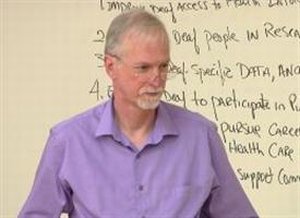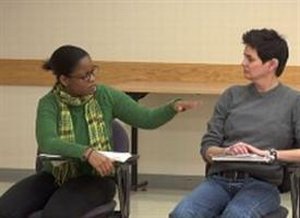American Sign Language Makes Debut in CDC Scientific Journal …
American Sign Language Makes Debut in CDC Scientific Journal


Aaron Kelstone leads classroom session in ASL web video
Thanks to a group of deaf and hearing Rochester, N.Y., pioneers, a medical journal for the first time has served up a scientific article online with a new twist: an accompanying web video in American Sign Language (ASL), produced by the University of Rochester Medical Center.
Preventing Chronic Disease, a journal published by the Centers for Disease Control and Prevention, in its March 2011 issue published a peer-reviewed article about health inequities experienced by deaf people. Steven Barnett, M.D., associate professor of Family Medicine and Community and Preventive Medicine,led the team of URMC physicians (which included two deaf faculty members) who wrote the article. They explained the four factors underlying the inequities and proposed several solutions.
Given the topic, however, it seemed especially important to reach out to the broadest possible audience, Barnett said. And in this case ASL is the primary language of approximately 500,000 Americans who have been deaf since birth.

Martina Bell (left) and Niki McKeown discuss health using ASL
The editor of Preventing Chronic Disease, Samuel F. Posner, Ph.D., suggested airing the video, which was produced as a collaboration of the Deaf Wellness Center and the Rochester Prevention Research Center: National Center for Deaf Health Research (NCDHR), both at URMC.
“Preventing Chronic Disease is committed to making public health research, program and policy advances accessible to all invested stakeholders,” Posner said. “Publishing in American Sign Language is an innovative step that scientific journals don’t commonly take. We believe doing so will enhance efforts to include and address the public health issues important to the Deaf community.”
“The bottom line is that this project reflects an attitude shift from being unaware of the Deaf community to one that focuses on the needs of the Deaf community — and for that we are thrilled,” said Barnett, associate director of the NCDHR, which was funded by the CDC in 2004 as the nation’s first center to focus on improving public health with the Deaf community.
Thomas A. Pearson, M.D., M.P.H., Ph.D., director of the NCDHR, agreed. “We congratulate the editors of Preventing Chronic Disease for their offer to provide the Deaf community with a summary of this report on the health of deaf persons,” he said. “This is a creative first step toward inclusion of the Deaf community which has almost always been excluded from information about health promotion and disease prevention.”
The article points out the striking absence of health care data on deaf people, due to the way researchers have traditionally collected such information – via telephone surveys and written mail. The problem with trying to reach deaf people solely through written English, Barnett noted, is that adults who have been deaf since birth have a wide range of English reading skills, from limited to proficient.
A lack of the most rudimentary health statistics in the deaf population make it impossible to set priorities, make improvements, or prevent disease, Barnett said. The authors also addressed the issues of low health literacy, poor doctor-patient communication, and emerging research on a possible biologic basis for some health differences between deaf and hearing people.
The article’s six recommendations for better public health are:
1. The need to address language barriers, such as using captions, transcripts and videos to communicate public health information.
2. Include more deaf people in health research by finding ways to overcome the mistrust stemming from prior negative health care experiences.
3. Collect new data and analyze existing data in more culturally appropriate ways. For example, a 60-year-old man deaf since birth and a 60-year-old man deaf since age 59 have very different life and health-care experiences.
4. Encourage deaf sign language users to participate in public health initiatives.
5. Encourage deaf sign language users to consider health careers. http://www.rit.edu/ntid/hccd/
6. Advocate for more funding for interpreter services and other programs that increase public health programs and research.
Tiffany Panko, M.B.A., a deaf member of the NCDHR research team, said it is her goal to go to medical school and she hopes this type of project will encourage others. “Personally, I’m inspired by this,” she said. “I’m thrilled and hope that this video gets more deaf people interested in pursuing careers in health care, public health, and health research.”
Robert Pollard, Ph.D, director of the URMC Deaf Wellness Center and producer of the ASL video, said it is unprecedented that a scientific article about deaf people was made accessible to deaf people in their primary language.
He noted that the folks at PCD understood that adapting health care material for deaf sign language users would involve more than simply translating it into ASL and producing a “talking head” video. Instead, the video takes the form of a 40-minute adapted film (in two parts), with a dynamic story line and dialogue between deaf characters.
“We have created many of these adapted films as a more interesting and relevant way to disseminate health education materials to the deaf community,” Pollard said, “and we are proud of this particular effort.”
Co-authors of the PCD journal article are: Pearson; Michael McKee, M.D., M.P.H., of the URMC Department of Family Medicine; and Scott R. Smith, M.D., M.P.H., of the Department of Community and Preventive Medicine.
Co-producers of the video include: Steve Fasone, Tiffany Panko, Robyn Dean, and Kim Kelstone.
* The above story is reprinted from materials provided by University of Rochester Medical Center


















